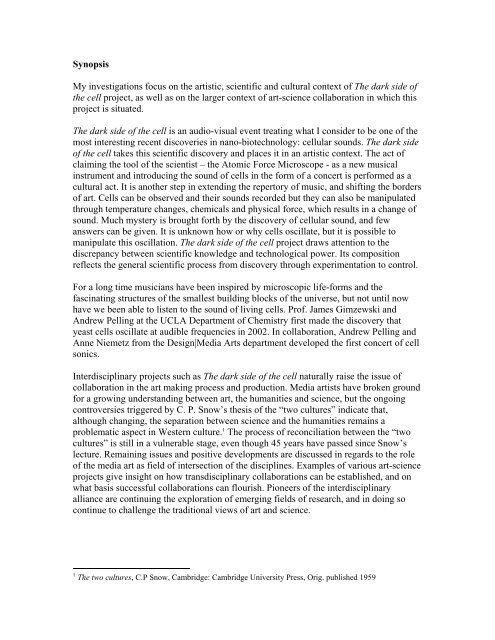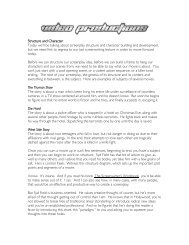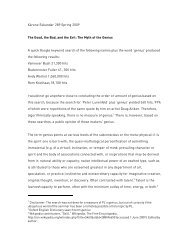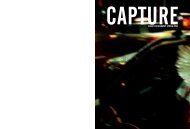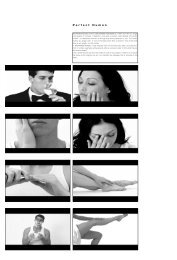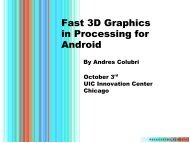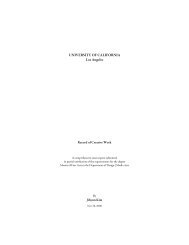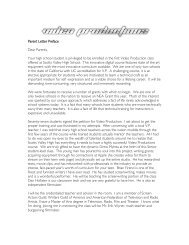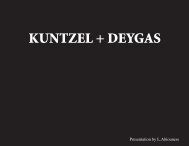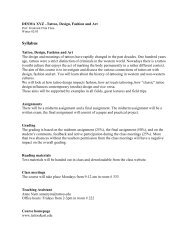Singing cells, art, science and the noise in between - Users - UCLA
Singing cells, art, science and the noise in between - Users - UCLA
Singing cells, art, science and the noise in between - Users - UCLA
Create successful ePaper yourself
Turn your PDF publications into a flip-book with our unique Google optimized e-Paper software.
Synopsis<br />
My <strong>in</strong>vestigations focus on <strong>the</strong> <strong>art</strong>istic, scientific <strong>and</strong> cultural context of The dark side of<br />
<strong>the</strong> cell project, as well as on <strong>the</strong> larger context of <strong>art</strong>-<strong>science</strong> collaboration <strong>in</strong> which this<br />
project is situated.<br />
The dark side of <strong>the</strong> cell is an audio-visual event treat<strong>in</strong>g what I consider to be one of <strong>the</strong><br />
most <strong>in</strong>terest<strong>in</strong>g recent discoveries <strong>in</strong> nano-biotechnology: cellular sounds. The dark side<br />
of <strong>the</strong> cell takes this scientific discovery <strong>and</strong> places it <strong>in</strong> an <strong>art</strong>istic context. The act of<br />
claim<strong>in</strong>g <strong>the</strong> tool of <strong>the</strong> scientist – <strong>the</strong> Atomic Force Microscope - as a new musical<br />
<strong>in</strong>strument <strong>and</strong> <strong>in</strong>troduc<strong>in</strong>g <strong>the</strong> sound of <strong>cells</strong> <strong>in</strong> <strong>the</strong> form of a concert is performed as a<br />
cultural act. It is ano<strong>the</strong>r step <strong>in</strong> extend<strong>in</strong>g <strong>the</strong> repertory of music, <strong>and</strong> shift<strong>in</strong>g <strong>the</strong> borders<br />
of <strong>art</strong>. Cells can be observed <strong>and</strong> <strong>the</strong>ir sounds recorded but <strong>the</strong>y can also be manipulated<br />
through temperature changes, chemicals <strong>and</strong> physical force, which results <strong>in</strong> a change of<br />
sound. Much mystery is brought forth by <strong>the</strong> discovery of cellular sound, <strong>and</strong> few<br />
answers can be given. It is unknown how or why <strong>cells</strong> oscillate, but it is possible to<br />
manipulate this oscillation. The dark side of <strong>the</strong> cell project draws attention to <strong>the</strong><br />
discrepancy <strong>between</strong> scientific knowledge <strong>and</strong> technological power. Its composition<br />
reflects <strong>the</strong> general scientific process from discovery through experimentation to control.<br />
For a long time musicians have been <strong>in</strong>spired by microscopic life-forms <strong>and</strong> <strong>the</strong><br />
fasc<strong>in</strong>at<strong>in</strong>g structures of <strong>the</strong> smallest build<strong>in</strong>g blocks of <strong>the</strong> universe, but not until now<br />
have we been able to listen to <strong>the</strong> sound of liv<strong>in</strong>g <strong>cells</strong>. Prof. James Gimzewski <strong>and</strong><br />
Andrew Pell<strong>in</strong>g at <strong>the</strong> <strong>UCLA</strong> Dep<strong>art</strong>ment of Chemistry first made <strong>the</strong> discovery that<br />
yeast <strong>cells</strong> oscillate at audible frequencies <strong>in</strong> 2002. In collaboration, Andrew Pell<strong>in</strong>g <strong>and</strong><br />
Anne Niemetz from <strong>the</strong> Design|Media Arts dep<strong>art</strong>ment developed <strong>the</strong> first concert of cell<br />
sonics.<br />
Interdiscipl<strong>in</strong>ary projects such as The dark side of <strong>the</strong> cell naturally raise <strong>the</strong> issue of<br />
collaboration <strong>in</strong> <strong>the</strong> <strong>art</strong> mak<strong>in</strong>g process <strong>and</strong> production. Media <strong>art</strong>ists have broken ground<br />
for a grow<strong>in</strong>g underst<strong>and</strong><strong>in</strong>g <strong>between</strong> <strong>art</strong>, <strong>the</strong> humanities <strong>and</strong> <strong>science</strong>, but <strong>the</strong> ongo<strong>in</strong>g<br />
controversies triggered by C. P. Snow’s <strong>the</strong>sis of <strong>the</strong> “two cultures” <strong>in</strong>dicate that,<br />
although chang<strong>in</strong>g, <strong>the</strong> separation <strong>between</strong> <strong>science</strong> <strong>and</strong> <strong>the</strong> humanities rema<strong>in</strong>s a<br />
problematic aspect <strong>in</strong> Western culture. 1 The process of reconciliation <strong>between</strong> <strong>the</strong> “two<br />
cultures” is still <strong>in</strong> a vulnerable stage, even though 45 years have passed s<strong>in</strong>ce Snow’s<br />
lecture. Rema<strong>in</strong><strong>in</strong>g issues <strong>and</strong> positive developments are discussed <strong>in</strong> regards to <strong>the</strong> role<br />
of <strong>the</strong> media <strong>art</strong> as field of <strong>in</strong>tersection of <strong>the</strong> discipl<strong>in</strong>es. Examples of various <strong>art</strong>-<strong>science</strong><br />
projects give <strong>in</strong>sight on how transdiscipl<strong>in</strong>ary collaborations can be established, <strong>and</strong> on<br />
what basis successful collaborations can flourish. Pioneers of <strong>the</strong> <strong>in</strong>terdiscipl<strong>in</strong>ary<br />
alliance are cont<strong>in</strong>u<strong>in</strong>g <strong>the</strong> exploration of emerg<strong>in</strong>g fields of research, <strong>and</strong> <strong>in</strong> do<strong>in</strong>g so<br />
cont<strong>in</strong>ue to challenge <strong>the</strong> traditional views of <strong>art</strong> <strong>and</strong> <strong>science</strong>.<br />
1 The two cultures, C.P Snow, Cambridge: Cambridge University Press, Orig. published 1959


